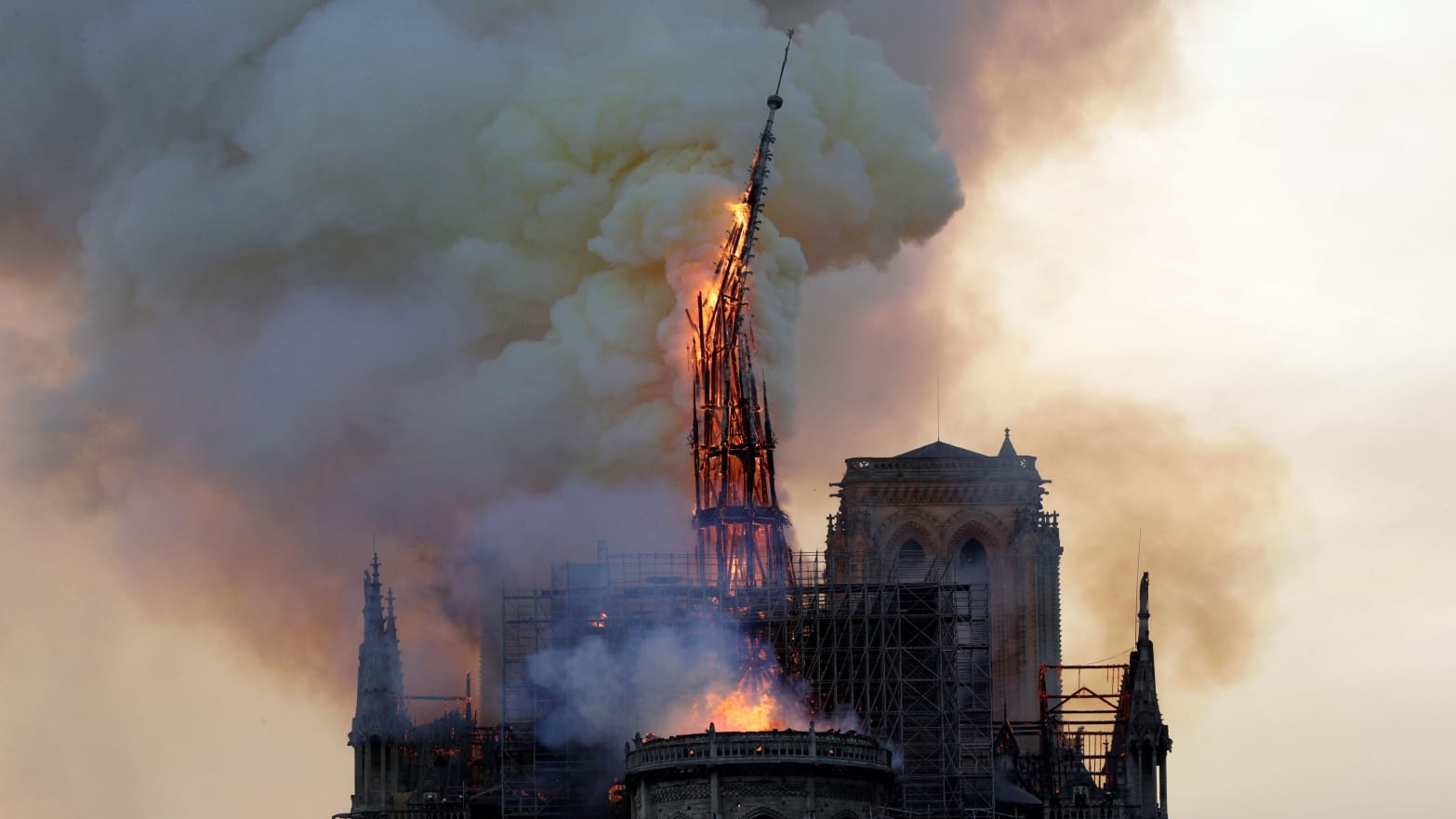PARIS—A sudden fire engulfed Notre Dame Cathedral on Monday, destroying centuries of history in minutes as the world looked on in helpless horror.
Flames pulled down the church’s towering spire in front of gasping onlookers nearby. The inferno burst through iconic stained-glass windows and charred the 800-year-old stone façade, apparently incinerating everything but the church’s skeleton. “Everything is burning,” a Notre Dame spokesperson put it bluntly.
French officials said the cathedral’s external stone structure will survive and that emergency responders salvaged its most precious art. The fire is now under control, according to officials, but firefighters are expected to work through the night.
Watching it all were thousands of people gathered along the banks of the Seine, barely moving or speaking as they watched a symbol of France burn to the ground. A large crowd gathered at the Place St. Michel and a group of about 20 people sang a Catholic hymn, evoking a funeral.
“She’s dead!” a disheveled-looked man in his fifties holding an open beer can yelled at the assembled crowd. “There is no use standing there looking, she is dead!”
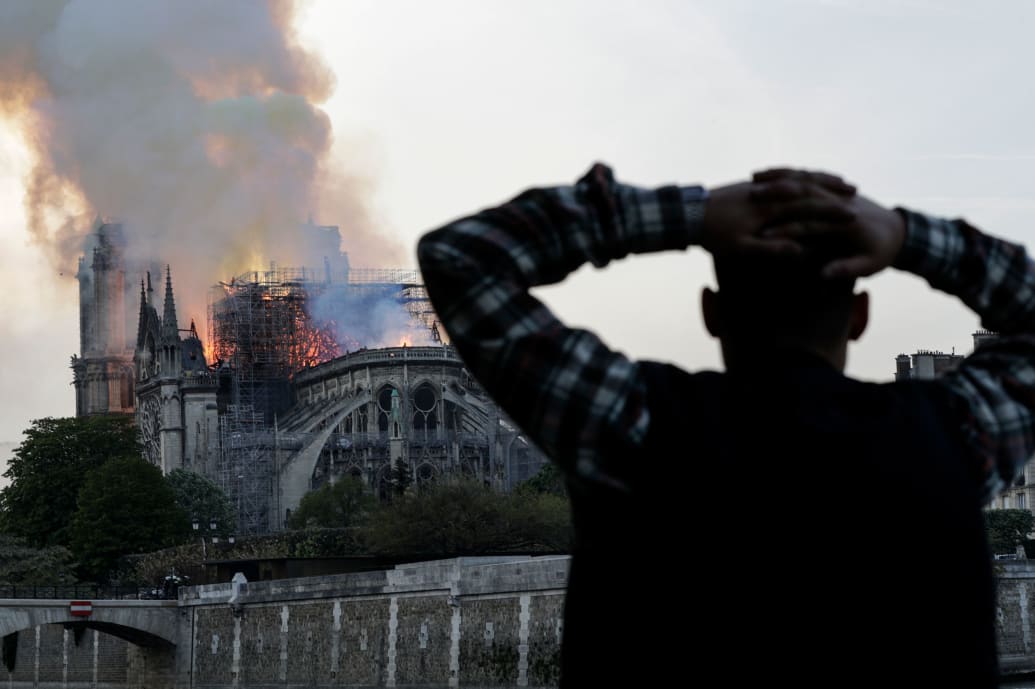
A man watches the landmark Notre Dame Cathedral burn.
Geoffroy Van Der Hasselt/AFP/Getty
Pascal Cambournac, a sales manager from Paris, jumped on his scooter and rushed to the river when he first heard the news. “This is the very heart of Paris and this is entire history of our country,” Cambournac, 53, said. “So many people came here to be in communion with this symbol of Christianity, of France. But whether you believe [in God] or not, this goes beyond faith,” he said.
Only three days ago, Rev. Yves Clochard Bossuet stopped at Notre Dame to say a prayer, as was his custom each time he passed the cathedral where he was ordained 20 years ago. “I always come. I love this church. It’s beautiful,” he said, overwhelmed by sadness. “I am so sorry. Notre Dame isn’t just a cathedral. It’s a symbol of all the history of France.”
Boussuet’s home parish is Notre-Dame de Foyers, which from its home in the working class 19th arrondissement lies about as far as you can get from its storied namesake in the heart of Paris.
“It’s not just a Parisian monument. It’s not just Christian. It’s not just French,” Bossuet said, as a group of people gathered around the priest hear him speak, many shaking their heads and overcome with emotion. “The entire world visits Notre Dame—every day.”
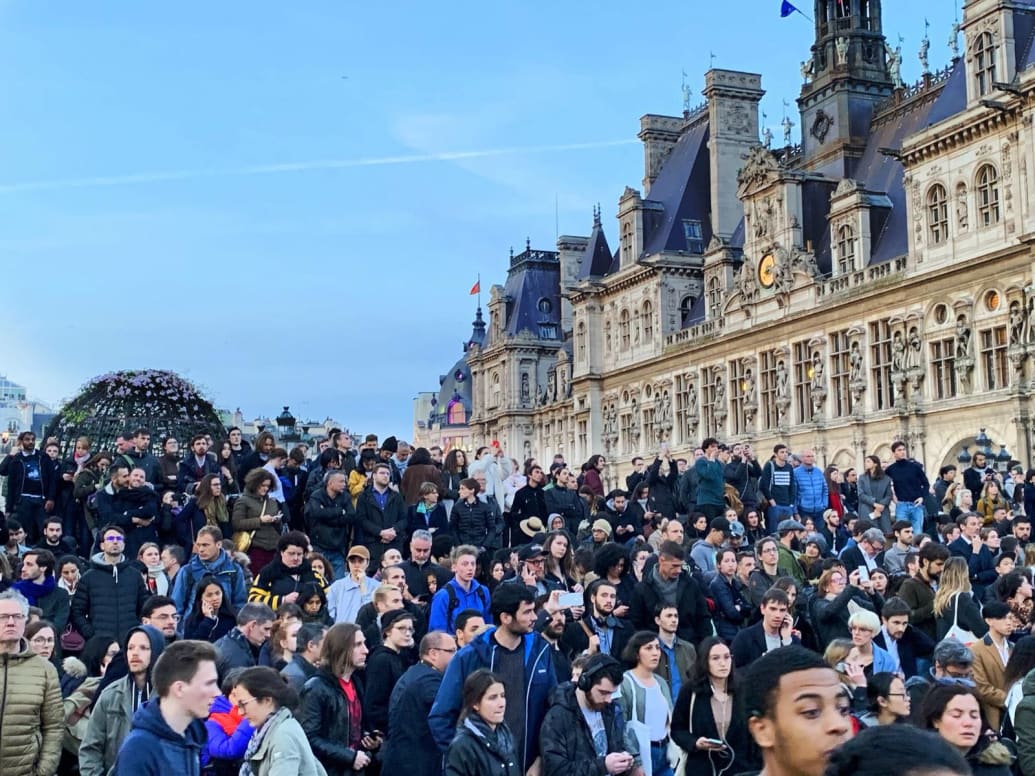
Onlookers on a bridge over the Seine watch Notre Dame burn.
Linda Hervieux
Lorenzo Fanti, a film student from Bologna, Italy, hadn’t had a chance to see Notre Dame during his eight months in Paris. “I think it’s finished now. There won’t be anything left. It’s very sad.”
Police shut two metro stations, roads, and bridges near the cathedral as firefighters battled the blaze. Even from a distance, there was an intense odor of acrid smoke coming from Notre Dame where jagged orange flames were still shooting skyward almost four hours after the fire began.
By 9 p.m. one of the iconic rectangular towers had also caught fire and the crowd let out an audible gasp. By then night had fallen, and an eerie orange glow could still be seen from the cathedral.
“My God, it’s still burning,” a man said.
The first reports of fire came shortly before 7 p.m., reportedly near the site of a multi-million dollar renovation. Paris prosecutors said they have launched an investigation into the fire which is tentatively being viewed as an accident. Flames were first seen near scaffolding close to the spire. About an hour after the fire started, the burning spire toppled over into the cathedral.
“Firemen are having a lot of trouble getting at the fire because of all the construction,” Emmanuel Gregoire, a spokesman for the Paris mayor’s office told French media. “They are doing their best but it’s not easy.”
The virtual destruction of France’s most historic building felt like a blow to the country itself, with President Emmanuel Macron postponing a national address to to Notre Dame. “Thinking of all Catholics and all French people. Like all my countrymen, I am so sad tonight to see a part of us burn,” he tweeted.
“It’s the worst image of Paris I’ve ever seen and I was here for the [2015] terrorist attacks,” Joanne Patton, an American and 21-year resident of Paris told The Daily Beast.
Maya Watson, 20, who born and raised in Paris, was watching the flames that engulfed the cathedral while speaking on the phone with The Daily Beast. “It’s apocalyptic. I don’t even have words,” she said.
She added: “The whole sky was bright orange and yellow. Fire trucks were everywhere. We were watching from our window and we saw the steeple fall. We saw it collapse. It’s so hard to put into words.”
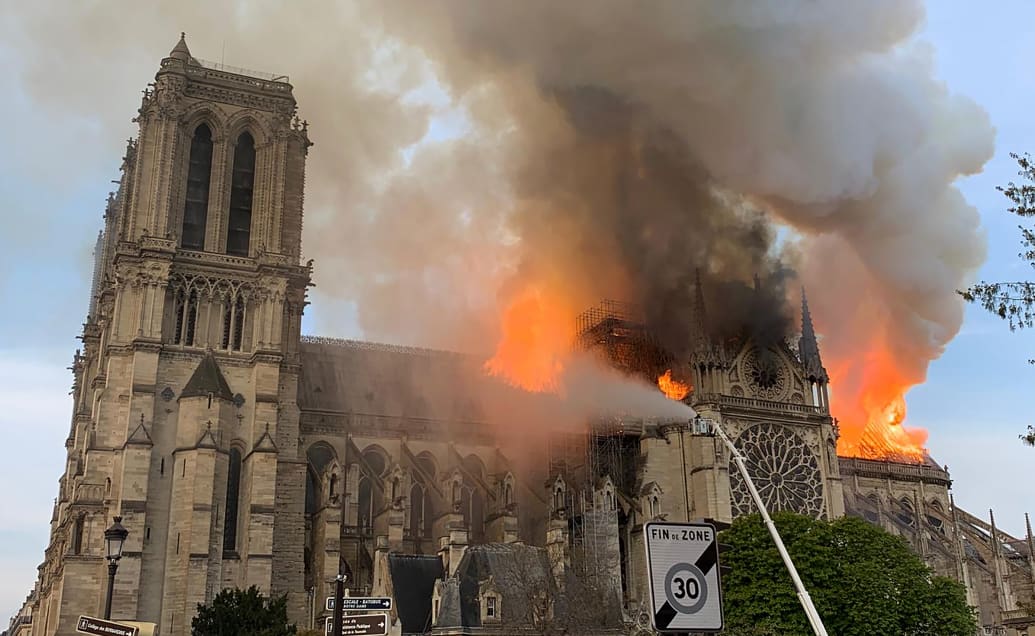
Flames and smoke are seen billowing from the roof at Notre-Dame Cathedral in Paris.
Patrick Andijar/Getty
French historian Camille Pascal sounded almost in tears when he recounted on French television what the iconic Catholic church means to France and the world.
“The cathedral of Notre Dame is impossible to separate from that of France and French national identity,” he said. “It means so much, it is fundamental to France and French values. It has endured. We have never seen it like this. Never.”
Later Monday, the first images from inside the church itself after the fire were released. The church’s walls were still intact, but the roof was burnt open and the remnants of the blaze looked like it they were still spreading smoke inside. Several fixtures, including a gold cross at the front of the church, looked to be intact.
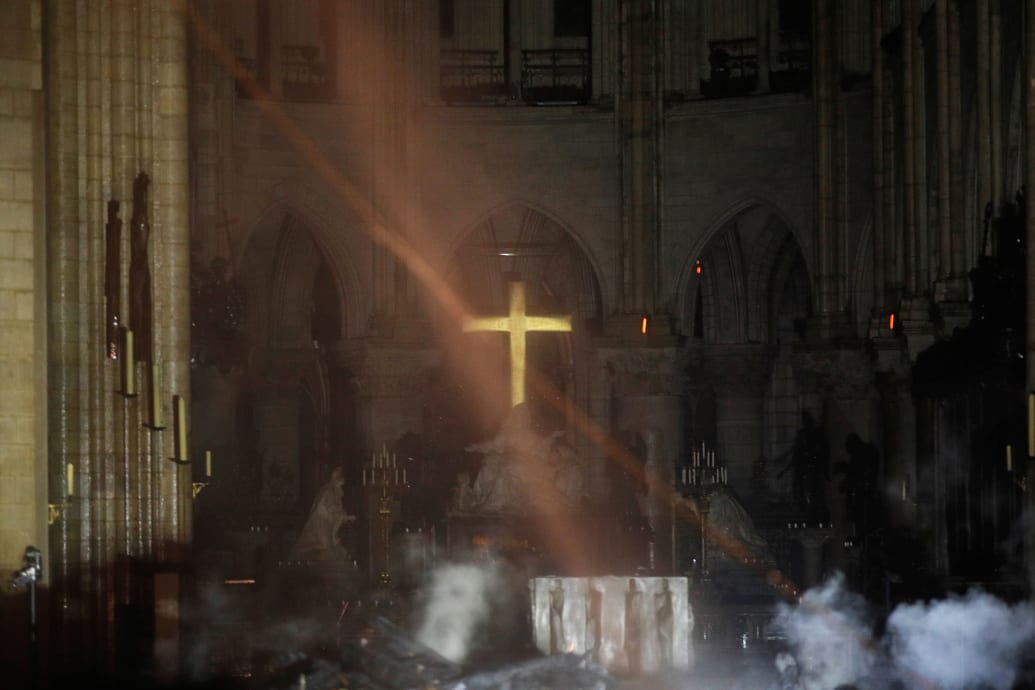
Philippe Wojazer/Reuters
Firefighters and municipal policeman were able to establish a “formidable human chain” to save many of the religious relics and art within the cathedral—including the Crown of Thorns and the tunic of Saint Louis—according to Paris Mayor Anne Hidalgo. By late Monday and early Tuesday morning, Agence France-Presse reported that officials said the fire “"under control” and “partially extinguished.”
According to figures from Paris’ tourism office, Notre Dame is the city’s most popular monument with more than 12 million visitors a year, double the number of visitors to the Eiffel Tower.
The iconic cathedral was first commissioned in 1163 by King Louis VII and completed in 1345, nearly 200 years later. It is on the Île de la Cité island in the Seine and was one of the largest buildings of its time to use what would come to be defined as Medieval Gothic architecture.
Notre Dame was one of the first major cathedrals to utilize “flying buttresses,” an architectural shortcut used to support and balance pressure in ancient building which were put in place when the stone walls started to fissure about 80 years into construction. The flying buttresses also allowed sunlight through decorative stained glass windows before electricity. Napoleon, who was crowned inside the cathedral in 1804, saved it from being demolished.
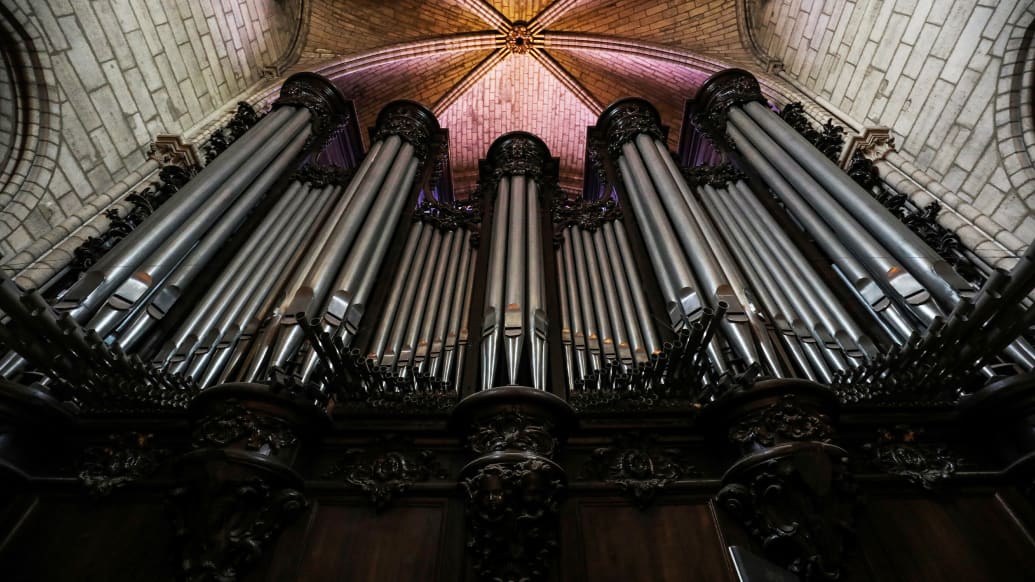
Organ at Notre Dame de Paris Cathedral in Paris.
Ludovic Marin/Getty
The treasures of Notre Dame go beyond its architecture. It’s also home to one of the most famous organs in the world, with 8,000 pipes; a spectacular stained glass rose windows dating from the 13th century; a treasury that contains sacred objects including crowns, chalices and robes worn by Napoleon. Paris’ emergency services are now reportedly trying to save the artwork stored in the cathedral.
“So much of the culture and history and identity of France are embodied by Notre Dame,” historian Bernard Lecomte told French media. “We are looking at the heart of Paris burn.”
The cathedral has faced destruction before. During the French Revolution many different parts of the cathedral were destroyed, including all of the bells except for the Emmanuel bell, all 28 statues from the Gallery of Kings, and all of the portal statues save for the Virgin in the Cloister.
An 1801 Concordat by Napoleon legitimized the Roman Catholic Church in France and led to restorations. In 1844, King Lous Philippe I started a renovation that many say is still underway today. The famous stained glass windows that adorned the building in the 12th century were recreated and put in place in 1965. The Great Organ was restored in 1992.
Sonya Georgieva and her friend Annabelle had come to the river when the news broke and they too saw the steeple fall. “It’s not possible,” she said, her voice trembling as she texted photos to her parents, who were out of the country on vacation.
“There are no words,” said her friend, Annabelle, as the two women slipped into the crowd on their way home, the fire still raging behind them.
—With Erin Zaleski and Linda Hervieux in Paris; Dana Kennedy in Nice, France; Barbie Latza Nadeau in Rome; Victoria Albert in New York.
